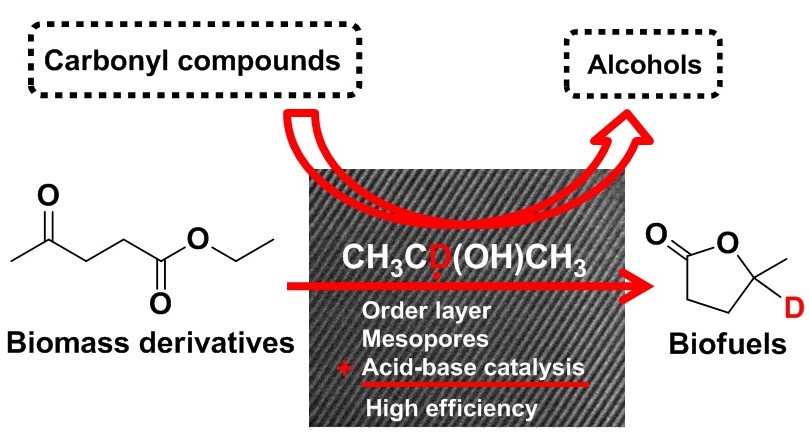Orderly layered Zr-benzylphosphonate nanohybrids for efficient transfer hydrogenation
Orderly layered Zr-benzylphosphonate nanohybrids for efficient transfer hydrogenation

Zirconium-xylylenediphosphonate nanohybrids, a class of unconventional metal-organic frameworks (UMOFs), are simply synthesized to have unique properties and are highly active for prodcuing biofules and chemicals via catalytic transfer hydrogenation
Catalytic transfer hydrogenation (CTH) is a sustainable and selective way to increase the hydrogen content of unsaturated molecules for producing either biofuels or valuable chemicals. Dr. Hu Li, a postdoctoral student, supervised by Profs. Song Yang (Guizhou university) and Zhen Fang prepared a series of mesoporous and orderly layered nanohybrids for the first time via simple and template-free assembly of zirconium with different xylylenediphosphonates. It was found that m-PhPZr nanoparticles (ca. 20-50 nm) with mesopores centered at 7.9 nm, and high molar ratio of Lewis acid to base sites (1:0.7) exhibited superior performance in CTH of ketones and biomass-derived aldehydes to corresponding alcohols with almost quantitative yields under mild conditions (as low as 82 ºC), especially in CTH of ethyl levulinate to the biofuel additive γ-valerolactone (up to 98% yield). It also showed high activity in one-pot production of biodiesel (with 89% yield) from high acid value oil, and in 5-hydroxymethylfurfural production (with 56% yield) via isomerization and dehydration of glucose. The catalyst is stable with little Zr leaching and deactivation after 5 cycles. Lewis acidic (Zr) and basic (PO3) centers of the heterogeneous catalyst were revealed to play a synergistic role in CTH of carbonyl compounds, e.g., ethyl levulinate to γ-valerolactone. Isotopic labeling experiments further indicated the occurrence of direct hydrogen transfer rather than metal hydride route.
The study was published:
H Li, Zhen Fang*, J He, S Yang, Orderly Layered Zr-Benzylphosphonate Nanohybrids for Efficient Acid/Base-Mediated Bifunctional/Cascade Catalysis, ChemSusChem, 10, 681–686 (2017).
———————————————————————-
介孔金属-有机膦酸层片材料的制备及其用于转移加氢合成生物燃料
催化转移加氢 (CTH; Catalytic transfer hydrogenation) 是一种可持续、选择性的方法来增加用于生产生物燃料或有价值的化学物质的不饱和分子中氢含量。生物能源组博士后李虎在杨松教授(贵州大学)和方真教授的指导下,通过简单、无模板的组装方法,用锆和不同的苯膦酸,合成了一系列的介孔和有序层状的纳米杂化材料。实验结果表明,m-PhPZr 纳米颗粒 (约 20-50 nm) 具有 7.9 nm介孔中心和高摩尔比的路易斯酸/碱 (1/0.7), 展现出在催化转移加氢酮和醛类生物质平台分子为相应的醇的优越性能,给出几乎定量的产率,反应温度温和(低至 82 º C),特别是在催化乙酰丙酸乙酯生成生物燃料γ-内酯具有高的活性(高达 98%的产率)。该催化剂,可从高酸值油脂中,一步法生产生物柴油 (产率为 89%),通过异构化和脱水葡萄糖生产5-羟甲基糠醛(产率为 56%)。催化剂表现出良好的稳定性,可以重复使用五次。在催化转移加氢羰基化合物(如乙酰丙酸乙酯合成 γ-戊内酯)时,刘易斯酸性 (Zr) 和碱(PO3) 中心发挥协同作用。同位素标记实验进一步预示着发生直接氢转移,而不是金属氢化物路线。
详情可见:
H Li, Zhen Fang*, J He, S Yang, Orderly Layered Zr-Benzylphosphonate Nanohybrids for Efficient Acid/Base-Mediated Bifunctional/Cascade Catalysis, ChemSusChem, 10, 681–686 (2017).